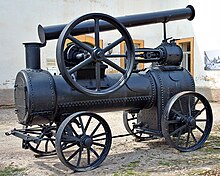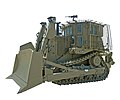Heavy equipment

Heavy equipment, heavy machinery, earthmovers, construction vehicles, or construction equipment, refers to
Heavy equipment has been used since at least the 1st century BC when the
Heavy equipment functions through the
The word plant, in this context, has come to mean any type of industrial equipment, including mobile equipment (e.g. in the same sense as
History

The use of heavy equipment has a long history; the
From horses, through steam and diesel, to electric and robotic




Until the 19th century and into the early 20th century heavy machines were drawn under human or animal power. With the advent of
The first commercial continuous track vehicle was the 1901 Lombard Steam Log Hauler. The use of tracks became popular for tanks during World War I, and later for civilian machinery like the bulldozer. The largest engineering vehicles and mobile land machines are bucket-wheel excavators, built since the 1920s.
"Until almost the twentieth century, one simple tool constituted the primary earthmoving machine: the
Container cranes were used from the 1950s and onwards, and made containerization possible.
Nowadays such is the importance of this machinery, some transport companies have developed specific equipment to transport heavy construction equipment to and from sites.
Most of the major equipment manufacturers such as Caterpillar,[2] Volvo,[3] Liebherr,[4] and Bobcat have released or have been developing fully or partially electric-powered heavy equipment. Commercially-available models and R&D models were announced in 2019 and 2020.[5]
Robotics and autonomy has been a growing concern for heavy equipment manufacturers with manufacturers beginning research and technology acquisition.[6] A number of companies are currently developing (Caterpillar and Bobcat) or have launched (Built Robotics) commercial solutions to the market.
Types
These subdivisions, in this order, are the standard heavy equipment categorization.
Tractor
- Bulldozer (dozer, track dozer)
- Snowcat
- Snowplow
- Skidder
- Tractor (wheel tractor)
- Track tractor
- Locomotive
- Artillery tractor
- Crawler-transporter
- Military engineering vehicles
Grader
Excavator
- Amphibious excavator
- Compact excavator
- Dragline excavator
- Dredger
- Bucket-wheel excavator
- Excavator (digger)
- Long reach excavator
- Power shovel
- Reclaimer
- Suction excavator
- Walking excavator
- Trencher
- Yarder
Backhoe
Timber
- Feller buncher
- Harvester
- Forwarder
- Skidder
- Power saw
- Track harvester
- Wheel forwarder
- Wheel skidder
Pipelayer
- Pipelayer (sideboom)
Scraper
- Fresno scraper
- Scraper
- Wheel tractor-scraper (belly scraper)
Mining
- Construction and mining tractor
- Construction and mining truck
- Dumper
- Dump truck
- Haul truck
- Mining equipment
Articulated
Compactor
- Wheel dozer (soil compactor)
- Soil stabilizer
Loader
- Loader (payloader, front loader, wheel loader, integrated tool carrier)
- Skip loader (skippy)
Track loader
- Track loader
Skid-steer loader
Material handler
- Aerial work platform, Lift table
- Crane
- Block-setting crane
- Bulk-handling crane
- Crane vessel
- Aerial crane
- Container crane
- Gantry crane
- Overhead crane
- Electric overhead traveling crane
- Ring crane
- Level luffing crane
- Mobile crane
- Travel lift
- Forklift
- Garbage truck
- Grapple truck, Knuckleboom loader (trailer mount)
- Straddle carrier
- Sidelifter
- Reach stacker
- Telescopic handlers
- Tow truck
Paving
- Asphalt paver
- Asphalt plant
- Cold planer
- Cure rig
- Paver
- Pavement milling
- Pneumatic tire compactor
- Roller (road roller, roller compactor)
- Slipform paver
- Vibratory compactor, Compactor
Underground
Hydromatic tool
- Ballast tamper
- Attachments
- Drilling rig
- Earth auger
- Pile driver
- Post pounder
- Rotary tiller(rototiller, rotovator)
Highway
- Tractor unit
- Ballast tractor
- Pushback tractor
- Railcar mover
- Highway 10 yard rear dump
- Highway bottom dump (stiff), pup (belly train), triple
- Highway end dump and side dump
- Highway transfer, Transfer train
- Concrete mixer
- Concrete mix truck
- Concrete mix dozer
- Lowboy (trailer)
- Street sweeper
- Street sweep truck
- Street sweep dozer
Images
-
The bucket excavator Komatsu PC210-LC.
-
The wheel trencherMARAISSMC 200 R.
-
Fixed crane in a coal mine in Germany
-
Caterpillar D9L bulldozer, excavators and other heavy equipment vehicles parked near a quarry in Israel
-
Bucket wheel excavators in Garzweiler surface mine, Germany
-
Wheel loader
-
Grader cleaning and leveling
-
Heavy duty excavator with large bucket equipped.
-
Landfill compactor (tamping tip)
-
Komatsu Dozer pushing coal on the job site
-
A wheeled front loader tractor equipped with a large bucket elevated by hydraulic rams.
-
Foldedconveyoron a tracked grinder
- Military engineering vehicles
-
The militarized Caterpillar D9 armored bulldozer allows for earthmoving projects in a combat environment. In the picture: IDF Caterpillar D9R.
-
Military scraper
-
PiPz Dachsarmoured engineering vehicle of the German Army(2008)
-
Temporary roads deployment complex during the "Armiya 2021" exhibition
Implements and hydromechanical work tools
- auger
- backhoe
- bale spear
- broom
- bulldozer blade
- clam shell bucket
- cold plane
- demolition shears
- equipment bucket
- excavator bucket
- forks
- grapple
- hoe ram
- hydraulics
- hydraulic tilting bucket (4-in-1)
- landscape tiller
- material handling arm
- mechanical pulverizer, crusher
- multi processor
- pavement removal bucket
- pile driver
- power take-off (PTO)
- quick coupler
- rake
- ripper
- rotating grab
- sheep's foot compactor
- skeleton bucket
- snow blower
- stump grinder
- stump shear
- thumb
- tiltrotator
- trencher
- vibratory plate compactor
- wheel saw
Traction: Off-the-road tires and tracks


Heavy equipment requires specialized
Heavy equipment operator
A heavy equipment operator drives and operates
Much publication about heavy equipment operators focuses on improving safety for such workers. The field of occupational medicine researches and makes recommendations about safety for these and other workers in safety-sensitive positions.
Equipment cost
Due to the small profit margins on construction projects it is important to maintain accurate records concerning equipment utilization, repairs and maintenance. The two main categories of equipment costs are ownership cost and operating cost.[9]
Ownership cost
To classify as an ownership cost an expense must have been incurred regardless of if the equipment is used or not. These costs are as follows:
- purchase expense
- salvage value
- tax savings from depreciation
- major repairs and overhauls
- property taxes
- insurance
- storage
Depreciation can be calculated several ways, the simplest is the straight-line method. The annual depreciation is constant, reducing the equipment value annually. The following are simple equations paraphrased from the Peurifoy & Schexnayder text:
|
m = some year in the future N = equipment useful life (years) and Dn = Annual depreciation amount
Book value (BV) in year m
|
example: N = 5 purchase price = $350,000 m = 3 years from now
|
Operating cost
For an expense to be classified as an operating cost, it must be incurred through use of the equipment. These costs are as follows:[10]
|
|
|
The biggest distinction from a cost standpoint is if a repair is classified as a major repair or a minor repair. A major repair can change the depreciable equipment value due to an extension in
Models
Notable manufacturers
The largest 10 heavy equipment manufacturers in 2022[12]
| No. | Company | Country | Sales (billion USD) | Share of total |
|---|---|---|---|---|
| 1 | Caterpillar | 37,5 | 16.3% | |
| 2 | Komatsu | 24,7 | 10.7% | |
| 3 | XCMG | 13,4 | 5.8% | |
| 4 | John Deere | 12,5 | 5.4% | |
| 5 | Sany | 11,9 | 5.2% | |
| 6 | Volvo Construction Equipment | 9,9 | 4.3% | |
| 7 | Liebherr | 9,9 | 4.3% | |
| 8 | Hitachi Construction Machinery | 9,2 | 4.0% | |
| 9 | Sandvik | 7,8 | 3.4% | |
| 10 | JCB | 7,0 | 3.0% |
Other manufacturers include:
- Anhui Heli
- Atlas Copco
- BEML Limited
- Bobcat Company
- Case Construction Equipment
- Chelyabinsk Tractor Plant
- CNH Global
- Demag
- Fiat-Allis
- HEPCO
- HIAB
- Hidromek
- Hyundai Heavy Industries
- Ingersoll Rand
- Kubota
- Kobelco
- LiuGong
- MARAIS
- Navistar International Corporation
- NCK
- New Holland
- Track Marshall
- Orenstein and Koppel GmbH(O&K)
- Paccar
- Poclain
- Rototilt
- Shantui
- ST Kinetics
- Takeuchi Manufacturing
- Wacker Neuson
- Yanmar
- Zoomlion
See also
- Construction equipment theft
- Non-road engine
- Associated Equipment Distributors, the trade association for heavy equipment distributors
References
- .
- ^ Lambert, Fred (January 29, 2019). "Caterpillar unveils an all-electric 26-ton excavator with a giant 300 kWh battery pack". Electrek. Wright’s Media. Retrieved July 14, 2020.
- ^ McLoud, Don (April 24, 2020). "Volvo CE gets $2M grant to test electric excavator, loader in California". Equipment World. Randall-Reilly. Retrieved July 14, 2020.
- ^ Gruver Doyle, Marcia (November 18, 2019). "Liebherr's prototype battery-powered LB 16 drilling rig has 10-hour run time (VIDEO)". Equipment World. Randall-Reilly. Retrieved July 14, 2020.
- ^ Rubenstone, Jeff (June 5, 2019). "Construction Equipment Goes Electric, But Hurdles Remain". Engineering News-Record. BNP Media. Retrieved July 14, 2020.
- ^ "Caterpillar Announces Acquisition of Robotic Expertise". Caterpillar. June 2020. Retrieved July 14, 2020.
- ^ U.S. Department of Labor – Occupational Outlook Handbook
- ISBN 0-7277-2519-X.
- ISBN 0-07-232176-8, 2002.
- ISBN 0-13-598327-4, 2000
- ^ "Heavy Equipment parts catalog". AGA Parts. Retrieved 2020-09-30.
- ^ "Construction equipment manufacturers: world equipment sales". Statista. Retrieved 2023-12-02.
External links
 Media related to Heavy equipment at Wikimedia Commons
Media related to Heavy equipment at Wikimedia Commons



















